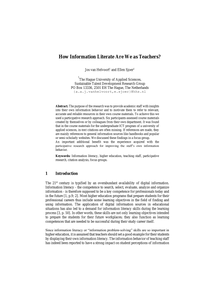Presentatie en Handout tijdens landelijke Studiekeuze123 conferentie, Jaarbeurs Utrecht
DOCUMENT

Presentatie en handout HMR over relatie BSA en studiesucces. Den Haag.
DOCUMENT

handout van een labtalk waarin de onderzoeker enkele methoden beschrijft rond text mining, story mining: het herkennen van patronen in communicatie met klanten.
DOCUMENT
Presentation at EFYE Conference, Bergen, Norway. Overview: •Dutch higher education in a nutshell •Quality in diversity: Strategic agenda for higher education Focus on: student-study fit •Moving forward enrolment date •Matching activities •First results
DOCUMENT

PPT presentatie tijdens de GTE Conference 2014
DOCUMENT

In our work as lecturers, teachers, researchers, coaches or managers in a university of applied sciences, we do feel that the amount and variety of societal challenges on higher vocational education (HVE) is growing. Institutions in HE are in a process of transforming from traditional ‘either or’ research or education institutions into more complex hybrid knowledge institutions. Nowadays, universities of applied sciences (as institutions for HVE) in The Netherlands have three main objectives: providing education, conducting practice-oriented research to add to the professional knowledge base, and contributing to innovation in the professional fields of work. Education, research and innovation form the three pillars in the strategy of Dutch Universities of Applied Sciences (Educational Council of The Netherlands, 2015). These changing societal demands form an impetus for educational reform and innovation at both organizational and individual employee levels (Cummings & Shin, 2014). Changes in context and roles lead to questions: As a teacher/lecturer/researcher, how do I relate to the different stakeholders? What is the real meaning of being a ‘good’ lecturer or researcher in creating added values, and for whom? Some propose that the new challenges concern everybody and thus should be everyone’s job. But when everything becomes everyone’s job, how can we really realize the required added values? Others promote a more differentiated approach of accurately fitting talents and tasks to create the flow and employee satisfaction that is needed to realize the desired outcomes. But then how do we work together and cooperate with such an individualistic approach? These opposing positions in the discourse concern the question of how to define the ‘professional me’ amongst the ‘we’. In other words, the challenge is how we define and navigate our professional identities within the context of a dynamic multiple-identity organization with increasing pressures for professional diversity (Foreman & Whetten, 2002; Aangenendt, 2015).
DOCUMENT

Tourism is on course to thwart humanity’s efforts to reach a zero carbon economy because of its high growth rates and carbon intensity. To get out of its carbon predicament, the tourism sector needs professionals with carbon literacy and carbon capability. Providing future professionals in the full spectrum of tourism-related study programmes with the necessary knowledge and skills is essential. This article reports on ten years of experience at a BSc tourism programme with a carbon footprint exercise in which students calculate the carbon footprint of their latest holiday, compare their results with others and reflect on options to reduce emissions. Before they start, the students are provided with a handout with emission factors, a brief introduction and a sample calculation. The carbon footprints usually differ by a factor of 20 to 30 between the highest and lowest. Distance, transport mode and length of stay are almost automatically identified as the main causes, and as the main keys for drastically reducing emissions. The link to the students’ own experience makes the exercise effective, the group comparison makes it fun. As the exercise requires no prior knowledge and is suitable for almost any group size, it can be integrated into almost any tourism-related study programme.
DOCUMENT

The Learning Technology Research Institute (LTRI) and the Association for Learning Technology (ALT) are two organisations within the UK that focus on ICT in the field of learning and teaching. Chapter of report on the Exchange Study Trip 2002, organised by SURF from the 21st till the 26th of April 2002.
DOCUMENT

The purpose of the research was to provide academic staff with insights into their own information behavior and to motivate them to refer to relevant, accurate and reliable resources in their own course materials. To achieve this we used a participative research approach. Six participants assessed course materials created by themselves or by colleagues from their own department. It was found that in the course materials for the undergraduate ICT program of a university of applied sciences, in-text citations are often missing. If references are made, they are mainly references to general information sources like handbooks and popular or semi-scholarly websites. We discussed these findings in a focus group. An important additional benefit was the experience acquired with the participative research approach for improving the staff’s own information behavior.
DOCUMENT
